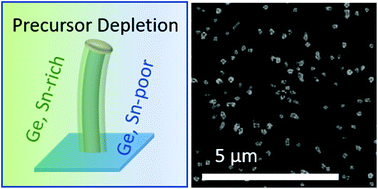Bending and precipitate formation mechanisms in epitaxial Ge-core/GeSn-shell nanowires†
Abstract
Core–shell Ge/GeSn nanowires provide a route to dislocation-free single crystal germanium-tin alloys with desirable light emission properties because the Ge core acts as an elastically compliant substrate during misfitting GeSn shell growth. However, the uniformity of tin incorporation during reduced pressure chemical vapor deposition may be limited by the kinetics of mass transfer to the shell during GeSn growth. The balance between Sn precursor flux and available surfaces for GeSn nucleation and growth determines whether defects are formed and their type. On the one hand, when the Sn precursor delivery is insufficient, local variations in Sn arrival rate at the nanowire surfaces during GeSn growth produce asymmetries in shell growth that induce wire bending. This inhomogeneous elastic dilatation due to the varying composition occurs via deposition of Sn-poor regions on some of the {112} sidewall facets of the nanowires. On the other hand, when the available nanowire surface area is insufficient to accommodate the arriving Sn precursor flux, Sn-rich precipitate formation results. Between these two extremes, there exists a regime of growth conditions and nanowire densities that permits defect-free GeSn shell growth.



 Please wait while we load your content...
Please wait while we load your content...
